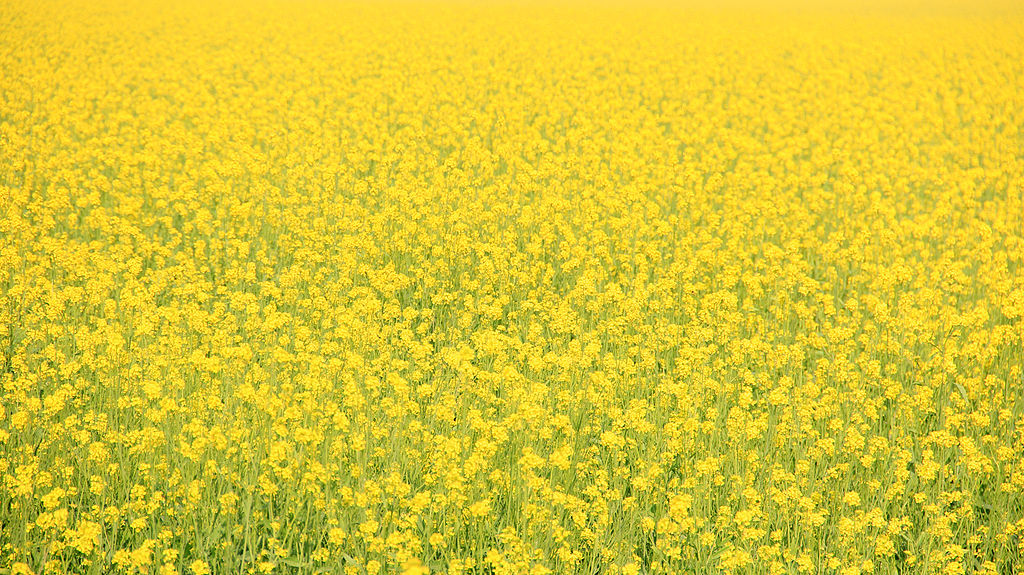Vasant Panchami, Welcoming Spring
"Vasant Panchami, also spelled Basant Panchami, is celebrated equally by Panjabis, Hindus, Muslims, Indian Muslim Sufis, and Sikhs in Pakistan, India, Nepal, Bangladesh, and Indonesia. Vasant is primarily a cultural festival that marks the arrival of spring. The people of the Panjab wear yellow clothes and eat yellow rice to emulate the yellow mustard (sarson) flower fields, or play by flying kites. Vasant Panchami also marks the start of preparation for Holika bonfire and Holi, which occurs forty days later." -- Wikipedia
From SeedFreedom --
Basant Panchami: Welcoming Spring, Celebrating Organic Mustard Diversity
The sun ripples through the trees across fields of towering bright yellow mustard flowers. An array of women farmers anxiously wait for the Sarsun Utsav program to begin, seated on the lawn of a local biodiversity and educational farm in the Dehradun valley. A bright yellow sign proclaims “Seed Freedom-Food Freedom Campaign,” guarded by a display of mustard flowers and a small golden Saraswati. Today marks Basant Panchami, in honor of the goddess of wisdom, Saraswati, and the coming of spring. To celebrate the occasion, Navdanya and local women’s food sovereignty groups have gathered today to fight against GM Mustard that threatens this sacred seed and India’s springs of the future.
The utsav, or celebration, begins with powerful educational speeches by local experts, who share the dangers of GM Mustard in India. For most of rural India, mustard oil is life. Women use this nutritious oil from the preparation of the most basic rotis to complex vegetable masala dishes. It is used to treat minor cuts, wounds, and infections. It is used for smooth skin and luscious hair. It is featured predominantly in both celebrations of birth and the mourning of death. Holy festivals are lit up by diyas filled with mustard oil. Its greens are consumed throughout the year—even in the coldness of winter—to provide health to families. It is the life of many people of India. Yet, Bt and GM Mustard threaten to introduce deadly chemicals and corrupted seed to India’s farmers.
The traditional knowledge of women and the biodiversity that protects the earth are threatened by the monocultures, intensive chemical input, and large processing factories that come with GM Mustard. Women’s caretaking of the seed, food, and sacredness of mustard is stripped away, while local oil mills are shut down and corporations take over the value chain from seed-to-oil. The women at Navdanya have joined together to combat this disastrous attempt, and on this Basant Panchami share their mustard seed biodiversity along with their traditional knowledge.
They begin by exchanging a diversity of mustard; each woman places a small handful of seed, hued from deep red to golden yellow to dark black, from her shawl into a communal bowl. Afterward, the seed is poured into a large wooden pestle. The elder aunties begin the process of pounding the seed—showing the younger women the traditional way of turning seed into oil. Each woman takes her turn, while some of the foreign volunteers at the educational farm attempt to learn too. After about an hour, with one woman always carefully pounding, two women holding the pestle, and one woman monitoring the small additions of water to the seed, the mustard begins to release its oil. The seed is placed in a cloth and squeezed to release its nutritious, sacred oil, and the farmers rejoice.
After this community exchange of knowledge, seed, and work, everyone shares in an organic lunch of fresh mustard greens eaten as raw salad, cooked mustard steamed with coriander and chili, and hearty rajma dal prepared with mustard oil. While the tone is of celebration and the joy of spring, it is clear that these farmers are ready to undertake the work to protect their biodiversity, their land, their seed, and their knowledge. As Dr. Vandana Shiva has said “mustard is the color of Basant, India’s Spring Festival” and these local women farmers are committed to keeping the basant panchamis of the future bright, yellow, and free.











